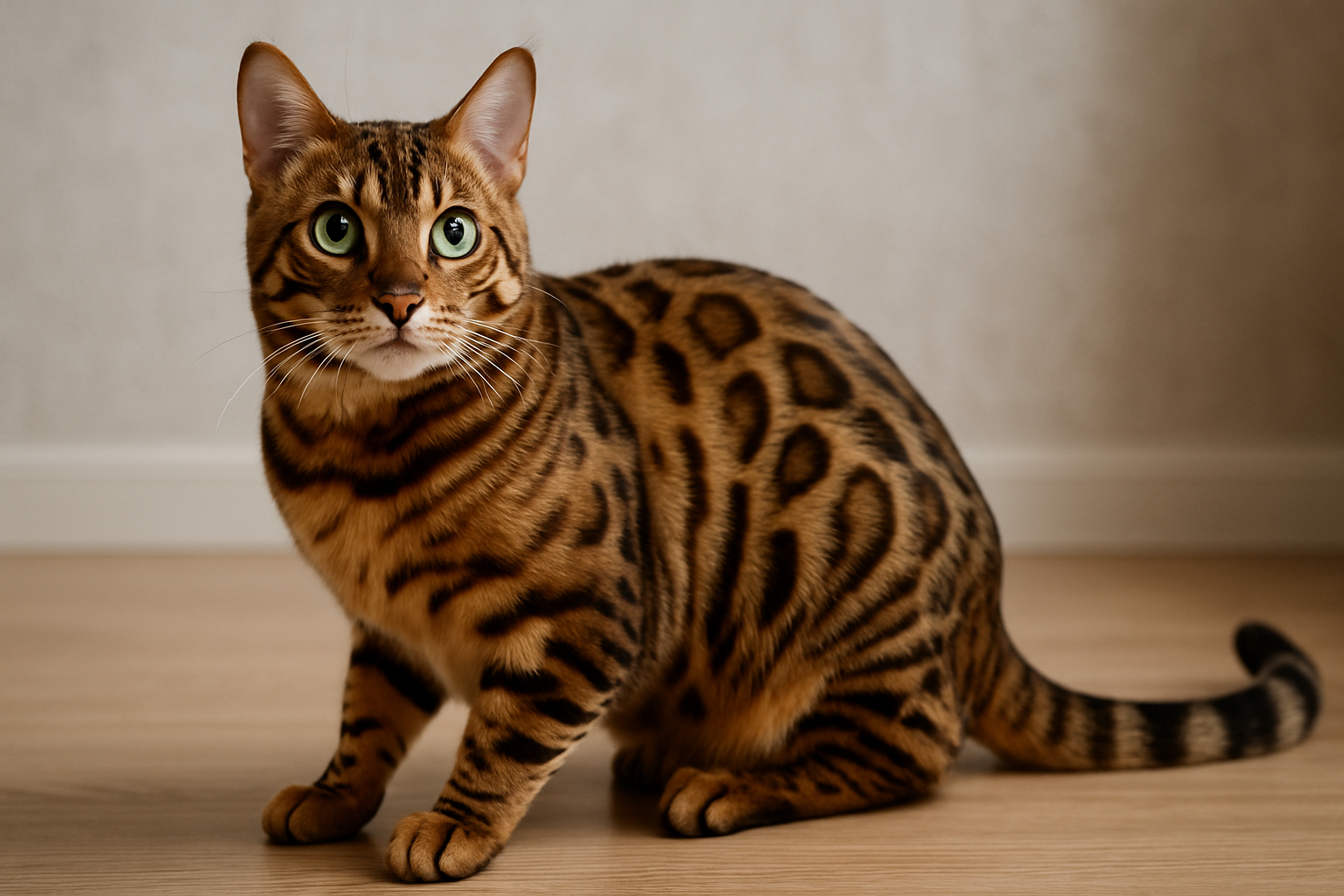Bengal cats have gained enormous popularity as a breed that combines the striking appearance of a wild leopard with the temperament of a domestic cat. These athletic, spotted felines offer a unique combination of beauty and personality that appeals to many cat enthusiasts.
Their exotic looks, playful nature, and high intelligence make them stand out in the world of domestic cats, though their energy and specific needs mean they aren’t the right fit for every household. This article explores everything you need to know about Bengal cats, from their fascinating origins to their care requirements and whether they might be the right pet for you.
Origins and History of the Bengal Cat
The Bengal cat breed has an interesting history that dates back further than many people realize. While many modern breeds were developed in the 20th century, the earliest mention of an Asian leopard cat crossed with a domestic cat actually appears in literature from 1889, when Harrison Weir wrote about such crosses in “Our Cats and All About Them”. However, these early experiments didn’t lead to an established breed.
The true development of the modern Bengal cat as we know it today is credited to Jean Mill of California. In the 1960s, Mill began a deliberate breeding program crossing Asian leopard cats (Prionailurus bengalensis) with domestic cats, particularly the spotted Egyptian Mau1. Her goal was to create a cat with the wild appearance of a leopard but with the friendly temperament of a domestic cat.
The breeding process wasn’t straightforward. The first generations of these hybrid cats, known as F1, G2, and G3 (or “foundation” Bengals), often had unpredictable temperaments due to their wild ancestry, and the males were frequently infertile. This meant that female early-generation Bengals needed to be bred with fertile domestic Bengal males of later generations to continue the breeding line.
The Bengal breed gained official recognition relatively recently. The International Cat Association (TICA) accepted Bengals as a “new breed” in 1986, and they achieved TICA championship status in 1991.
Other cat registries followed: the Governing Council of the Cat Fancy (GCCF) accepted Bengal cats in 1997, while both the Fédération Internationale Féline (FIFe) and the Australian Cat Federation (ACF) recognized the breed in 1999.
The Cat Fanciers’ Association (CFA) was more cautious, only accepting Bengals in their “Miscellaneous” category in 2016, with the requirement that they must be F6 or later – meaning at least six generations removed from their Asian leopard cat ancestors.
Today’s Bengal cats typically have wild ancestors many generations back in their pedigree, making them fully domestic cats in temperament while maintaining their distinctive wild appearance.
Physical Characteristics That Set Bengals Apart
Distinctive Appearance
Bengal cats are immediately recognizable for their wild appearance, which strongly resembles their Asian leopard cat ancestors. These medium-to-large cats have athletic, muscular bodies that exhibit strength and agility. They typically weigh between 8 to 15 pounds, though some can be larger.
One interesting aspect of their physical structure is that their back legs are slightly longer than their front legs, giving their hindquarters a slightly higher stance than their shoulders. This distinctive posture contributes to their wild appearance and provides them with impressive jumping abilities.
Their heads are relatively small and proportionate, not particularly wide or long, with muzzles that maintain their width rather than tapering at the end. Their ears are another distinctive feature – short, small, wide at the base, with rounded ends that point forward and often display darker tips. Bengals also have long, thick, strong necks that support their athletic movements.
Coat Patterns and Colors
The most striking feature of Bengal cats is undoubtedly their coat. Their short, thick, soft, and shiny fur displays patterns that mimic those of wild leopards. These patterns can take several forms:
- Spots: Distinct spots are scattered across the coat
- Rosettes: Spots with a darker outline surrounding a lighter center, resembling a rose
- Arrowhead markings: Triangular spots pointing toward the rear of the cat
- Marbling: Swirled patterns with high contrast
Bengal coats also often exhibit a special quality called “glitter” – an iridescent sheen that makes their coat appear to sparkle in certain light.
As for colors, Bengal cats come in various shades recognized by cat associations. The International Cat Association recognizes several color variations including chocolate spotted, seal lynx point (snow), sepia, silver, and mink spotted tabby. The most popular and recognizable coat color is the brown spotted/rosetted pattern, but Bengals can also exhibit colors such as red, chocolate, and black, with patterns including ticked, spotted, rosetted, or clouded.
Personality and Temperament: Not Your Average House Cat
Intelligence and Activity Level
Bengal cats are renowned for their high intelligence and exceptional activity level. These are not typical lap cats that will spend most of their day sleeping – they’re curious, energetic, and need considerable mental and physical stimulation.
Their intelligence is both a blessing and a challenge for owners. Bengals can learn tricks, solve puzzles, and even understand some commands, making them highly trainable. Many Bengal owners report success with clicker training and teaching their cats various tricks that would challenge even some dogs.
However, this intelligence also means they can get bored easily, and a bored Bengal is often a destructive Bengal. These clever cats have been known to figure out how to open drawers and cabinets out of curiosity, and they might take items that catch their interest and hide them. Bengal owners often joke about needing to “childproof” their homes to prevent their cats from getting into mischief.
Unique Behavioral Traits
Bengals exhibit several behaviors that set them apart from other domestic cats, likely due to their wild ancestry:
- Water fascination: Unlike most cats that avoid water, Bengals are often drawn to it. They might jump into bathtubs, play with running faucets, or even join their owners in the shower. Some have been known to swim alongside their owners in pools. When drinking, they might dip a paw into the water and lick it off rather than drinking directly from the bowl.
- Climbing drive: Bengals have a strong instinct to climb and perch at high vantage points. They need vertical territory and will often seek the highest reachable point in a home. Without appropriate climbing structures, they may attempt to scale curtains, bookcases, or other furniture.
- Hunting instincts: Their wild heritage gives them strong hunting instincts. They’re excellent hunters and will actively stalk toys, bugs, or, unfortunately, fish in aquariums if given the chance.
- Vocalization: Many Bengal owners report that their cats are quite vocal, with a range of distinct sounds beyond typical meowing. They may chirp, trill, or make other unusual vocalizations to communicate with their owners.
Social Behavior
Despite their wild appearance and high energy, well-socialized Bengals are typically friendly and affectionate with their human family members. They often bond strongly with their owners and will follow them from room to room, wanting to be involved in whatever activities are happening.
Bengals generally get along well with other pets, including dogs, though individual personalities can vary. Due to their territorial nature, introducing adult Bengals to other cats can sometimes be challenging. For multi-cat households, getting cats at the same time or when they’re young often leads to better relationships.
They typically interact well with children, as they enjoy the energy and playfulness kids provide. However, very young children should always be supervised with Bengals (as with any cat), as these active cats may not appreciate rough handling.
Caring for a Bengal Cat: Meeting Their Unique Needs
Exercise Requirements
Bengals have significantly higher exercise needs than many other cat breeds. Their athletic builds and high energy levels mean they require plenty of opportunities for physical activity. Owners should plan for multiple play sessions throughout the day, with toys that simulate hunting and allow for running and jumping.
Interactive toys, puzzle feeders, and cat wheels can help provide the physical and mental stimulation Bengals need. Without adequate exercise, these cats may develop behavioral problems due to pent-up energy.
Environmental Enrichment
Creating an enriching environment is crucial for Bengal cats. Their home should include:
- Tall cat trees or shelves for climbing and perching
- Various hiding spots and tunnels for exploration
- Rotating toys to prevent boredom
- Window perches where they can watch outdoor activity
- Puzzle toys that challenge their intelligence
Many Bengal owners install cat shelves along walls or create custom “catios” (enclosed outdoor spaces) to provide their pets with more territory to explore safely.
Grooming and Basic Care
Fortunately, Bengal cats have relatively low-maintenance coat care needs. Their short, plush coats require only weekly brushing to remove loose fur and distribute natural oils. They typically groom themselves effectively, though they do shed seasonally like most cats.
Their nails should be trimmed regularly, and their teeth should be brushed frequently to prevent dental disease. Most Bengals become accustomed to these care routines if introduced gently from a young age.
Health Considerations
While generally healthy, Bengal cats can be prone to certain genetic conditions:
- Hypertrophic cardiomyopathy (HCM): A form of heart disease
- Progressive retinal atrophy (PRA): A degenerative eye condition
- Pyruvate kinase deficiency: An inherited blood disorder
- Patella luxation: Displacement of the kneecap
Responsible breeders test their breeding cats for these conditions to reduce their occurrence in kittens. Regular veterinary check-ups are essential for early detection of any health issues.
As with all cats, maintaining a healthy weight through proper diet and exercise is important for preventing obesity-related health problems. Bengals particularly benefit from high-quality protein diets that satisfy their natural carnivorous needs.
Is a Bengal Cat Right for Your Home?
Ideal Environment for a Bengal
Bengals thrive in homes where they:
- Have plenty of space to run and play
- Are provided with climbing opportunities
- Receive daily interactive play and mental stimulation
- Have consistent human interaction
- Are given appropriate outlets for their energy and hunting instincts
Many successful Bengal owners have homes with ample vertical space, secure outdoor enclosures, or large indoor areas where these active cats can exercise.
Who Should Consider a Bengal
Bengals can be wonderful companions for:
- Active individuals or families who can provide plenty of interaction
- People who enjoy playful, intelligent pets and want to engage in training
- Those who appreciate the Bengal’s wild appearance but want a domestic pet
- Households where someone is home frequently
- Experienced cat owners looking for a more engaging feline companion
Who Should Think Twice
Bengals may not be the best fit for:
- First-time cat owners who might be overwhelmed by their energy and needs
- People seeking a calm, lap cat that requires minimal interaction
- Those who spend long hours away from home without providing alternative stimulation
- Individuals who cannot provide adequate space or enrichment
- Households with very small children who might not respect the cat’s boundaries
Conclusion
Bengal cats represent a fascinating bridge between wild and domestic felines. With their striking appearance, playful nature, and remarkable intelligence, they offer a unique companion experience unlike any other domestic cat breed. Their leopard-like spots and athletic build turn heads, while their engaging personalities create strong bonds with their human families.
However, these special qualities come with responsibility. Bengals require owners who understand and can meet their need for physical activity, mental stimulation, and environmental enrichment. They’re not the right cat for everyone, but for those who can provide the right home, they offer an unparalleled feline relationship.
Whether you’re drawn to their wild appearance, charmed by their playful antics, or intrigued by their intelligent nature, Bengal cats certainly stand out in the world of domestic cats. For the right owner, a Bengal can be an extraordinarily rewarding companion that brings the spirit of the wild into your home, packaged in a domestic cat that fits – somewhat – into family life.
- Parrotlets (Personality, Care, Health, Nutrition, & Cost) - June 20, 2025
- Caique (Personality, Care, Health, & Nutrition) - June 20, 2025
- The Complete Guide to Golden Retrievers - June 9, 2025















